Do you have a question about the Philips HTS8100/98 and is the answer not in the manual?
Indicates the period during which toxic substances will not leak or mutate, preventing pollution or damage.
Refers to the period of safe use for batteries, preventing leaks or mutations.
Details the type, wavelength, output power, and beam divergence of the laser.
Warns about hazardous radiation exposure from controls or adjustments.
Guidance for safe and optimal unit placement and installation.
Instructions on ensuring adequate airflow around the unit to prevent overheating.
Warnings against exposing the unit to water, moisture, or extreme temperatures.
List of items included with the home theatre system.
Information on responsible disposal of electronic equipment and packaging.
Diagram and labels for the top view of the main unit.
Diagram and labels for the left side view of the main unit.
Diagram and labels for the front view, detailing controls and indicators.
Identification and function of the primary buttons on the remote control.
Explanation of buttons used to select input sources.
Function of buttons related to disc menu navigation and playback.
Function of buttons for sound modes, subtitles, angles, and zoom.
Step-by-step guide for inserting batteries into the remote control.
Instructions on how to operate the remote control effectively.
Guidance on positioning the main unit and subwoofer for optimal placement.
Instructions for connecting the unit to a TV via composite video cable.
Instructions for connecting the unit to a TV via HDMI for digital audio/video.
Instructions for connecting the unit to a TV using component video for progressive scan.
Details on connecting the subwoofer to the main unit using interconnect cables.
Instructions for connecting FM and AM/MW antennas for radio reception.
Steps for connecting the main unit and subwoofer to a power outlet.
How to connect TV audio output to the home theater system for surround sound.
How to connect cable boxes or VCRs for audio input.
Step-by-step instructions for wall-mounting the main unit securely.
Guide to selecting the correct TV input channel for video playback.
Initial setup for speaker configuration based on room acoustics and placement.
Guidance on positioning the Sound Bar system and adjusting its height.
Setting the distance between the listening position and the speakers.
How to set the language for the unit's on-screen display menus.
Setting preferred language for DVD audio, subtitles, and disc menus.
Adjusting the picture aspect ratio to match the connected TV.
Configuring the progressive scan output for enhanced picture quality.
How to switch between different input sources like DISC, DOCK, USB.
Instructions on how to put the unit into low power standby mode.
List of disc formats supported by the home theatre system.
Step-by-step guide on how to insert and play a disc.
How to pause, resume, select tracks, search, and stop playback.
How to select different playback modes like repeat and shuffle.
How to create a custom playback sequence of tracks on a disc.
How to navigate and use the disc's menu for playback options.
How to display disc information like title, chapter, audio, and subtitle status.
How to zoom and pan the video picture during playback.
How to select different subtitle languages for DVD playback.
How to select different camera angles for DVDs that support this feature.
How to select different audio tracks or channels for DVDs and VCDs.
How to adjust audio delay to correct lip-sync issues.
How to use interactive playback features for VCDs with PBC enabled.
Instructions for playing MP3 and WMA audio files and JPEG images from discs.
How to play a slideshow of JPEG images from a disc.
How to view thumbnail previews and navigate pictures.
How to zoom, pan, rotate, or flip pictures displayed from a disc.
How to create a musical slideshow with audio and images from a disc.
Instructions for playing DivX movie files from discs.
How to play music from iPod devices using the docking station.
Information on supported iPods and preparation for connection.
How to play or view files (JPEG, MP3, DivX) from USB storage devices.
How to connect and play audio from portable devices via MP3 LINE-IN.
Instructions on how to enter and navigate the system setup menus.
Overview of General Setup menu options and their page references.
Overview of Audio Setup menu options and their page references.
Overview of Video Setup menu options and their page references.
Overview of Preference menu options and their page references.
Configuration options for the Ambisound surround sound system.
How to lock specific discs to prevent playback.
Adjusting the brightness of the unit's display panel.
Setting the language for the unit's on-screen display.
Enabling or disabling the screen saver function.
Setting the sleep timer for automatic standby mode.
Information on DivX Video on Demand registration codes.
Configuration of audio output when using an HDMI connection.
Selecting TV color system and adjusting picture aspect ratio.
Selecting picture color settings and enabling progressive scan output.
Advanced picture settings including DCDi, Gamma, Chroma Delay, True Life, HDMI Video.
Advanced picture settings for P-Scan Format and wide-screen display.
Settings for preferred audio, subtitle, and disc menu language.
Setting parental controls and enabling/disabling Playback Control for VCD/SVCD.
Configuring navigation menus for MP3/JPEG discs.
Managing passwords for Disc Lock and Parental controls.
Selecting the font type for DivX subtitles.
Resetting all setup menu options and personal settings to factory defaults.
Steps to find and tune into FM and AM/MW radio stations.
Adjusting the frequency step for tuning radio stations.
Methods for storing favorite radio stations into memory.
Automatically installing all available radio stations upon first use.
Storing or reinstalling preset radio stations using automatic methods.
Manually storing favorite radio stations by assigning preset numbers.
How to select a stored preset radio station.
How to remove a stored preset radio station from memory.
Adjusting the main volume level and muting the sound output.
Customizing the bass and treble audio frequencies for desired sound.
Choosing between different surround sound modes (Auto, Multi-channel, Stereo).
Choosing preset sound effects to match music or movie genres.
Steps to upgrade the unit's software for enhanced features and performance.
Solutions for common issues like no power, no picture, or distorted sound.
Solutions for playback issues, unplayable discs, and aspect ratio problems.
Troubleshooting for poor radio reception and general unit failure.
Solutions for issues related to USB, HDMI, and iPod dock connections and playback.
Explains slow USB file display and file name differences.
Details on unsupported USB devices, HDDs, and music player detection.
Reasons why certain files may not play or pictures may not rotate.
Technical specifications for the amplifier section of the unit.
Physical dimensions and speaker details for the main unit.
Technical specifications for the subwoofer, including power and dimensions.
Specifications for the disc playback system, laser type, and video decoding.
Technical specifications for the radio tuner section.
Definitions of analog audio, aspect ratio, AUDIO OUT jacks, bit rate, chapter, and composite video.
Definitions of disc menu, DivX, Dolby Digital, Dolby Surround Pro Logic II, DTS, HDMI, and HDCP.
Definitions of JPEG, MP3, MPEG, Multi-channel, PBC, Progressive Scan, region code, Surround, Title, WMA.
Indicates the period during which toxic substances will not leak or mutate, preventing pollution or damage.
Refers to the period of safe use for batteries, preventing leaks or mutations.
Details the type, wavelength, output power, and beam divergence of the laser.
Warns about hazardous radiation exposure from controls or adjustments.
Guidance for safe and optimal unit placement and installation.
Instructions on ensuring adequate airflow around the unit to prevent overheating.
Warnings against exposing the unit to water, moisture, or extreme temperatures.
List of items included with the home theatre system.
Information on responsible disposal of electronic equipment and packaging.
Diagram and labels for the top view of the main unit.
Diagram and labels for the left side view of the main unit.
Diagram and labels for the front view, detailing controls and indicators.
Identification and function of the primary buttons on the remote control.
Explanation of buttons used to select input sources.
Function of buttons related to disc menu navigation and playback.
Function of buttons for sound modes, subtitles, angles, and zoom.
Step-by-step guide for inserting batteries into the remote control.
Instructions on how to operate the remote control effectively.
Guidance on positioning the main unit and subwoofer for optimal placement.
Instructions for connecting the unit to a TV via composite video cable.
Instructions for connecting the unit to a TV via HDMI for digital audio/video.
Instructions for connecting the unit to a TV using component video for progressive scan.
Details on connecting the subwoofer to the main unit using interconnect cables.
Instructions for connecting FM and AM/MW antennas for radio reception.
Steps for connecting the main unit and subwoofer to a power outlet.
How to connect TV audio output to the home theater system for surround sound.
How to connect cable boxes or VCRs for audio input.
Step-by-step instructions for wall-mounting the main unit securely.
Guide to selecting the correct TV input channel for video playback.
Initial setup for speaker configuration based on room acoustics and placement.
Guidance on positioning the Sound Bar system and adjusting its height.
Setting the distance between the listening position and the speakers.
How to set the language for the unit's on-screen display menus.
Setting preferred language for DVD audio, subtitles, and disc menus.
Adjusting the picture aspect ratio to match the connected TV.
Configuring the progressive scan output for enhanced picture quality.
How to switch between different input sources like DISC, DOCK, USB.
Instructions on how to put the unit into low power standby mode.
List of disc formats supported by the home theatre system.
Step-by-step guide on how to insert and play a disc.
How to pause, resume, select tracks, search, and stop playback.
How to select different playback modes like repeat and shuffle.
How to create a custom playback sequence of tracks on a disc.
How to navigate and use the disc's menu for playback options.
How to display disc information like title, chapter, audio, and subtitle status.
How to zoom and pan the video picture during playback.
How to select different subtitle languages for DVD playback.
How to select different camera angles for DVDs that support this feature.
How to select different audio tracks or channels for DVDs and VCDs.
How to adjust audio delay to correct lip-sync issues.
How to use interactive playback features for VCDs with PBC enabled.
Instructions for playing MP3 and WMA audio files and JPEG images from discs.
How to play a slideshow of JPEG images from a disc.
How to view thumbnail previews and navigate pictures.
How to zoom, pan, rotate, or flip pictures displayed from a disc.
How to create a musical slideshow with audio and images from a disc.
Instructions for playing DivX movie files from discs.
How to play music from iPod devices using the docking station.
Information on supported iPods and preparation for connection.
How to play or view files (JPEG, MP3, DivX) from USB storage devices.
How to connect and play audio from portable devices via MP3 LINE-IN.
Instructions on how to enter and navigate the system setup menus.
Overview of General Setup menu options and their page references.
Overview of Audio Setup menu options and their page references.
Overview of Video Setup menu options and their page references.
Overview of Preference menu options and their page references.
Configuration options for the Ambisound surround sound system.
How to lock specific discs to prevent playback.
Adjusting the brightness of the unit's display panel.
Setting the language for the unit's on-screen display.
Enabling or disabling the screen saver function.
Setting the sleep timer for automatic standby mode.
Information on DivX Video on Demand registration codes.
Configuration of audio output when using an HDMI connection.
Selecting TV color system and adjusting picture aspect ratio.
Selecting picture color settings and enabling progressive scan output.
Advanced picture settings including DCDi, Gamma, Chroma Delay, True Life, HDMI Video.
Advanced picture settings for P-Scan Format and wide-screen display.
Settings for preferred audio, subtitle, and disc menu language.
Setting parental controls and enabling/disabling Playback Control for VCD/SVCD.
Configuring navigation menus for MP3/JPEG discs.
Managing passwords for Disc Lock and Parental controls.
Selecting the font type for DivX subtitles.
Resetting all setup menu options and personal settings to factory defaults.
Steps to find and tune into FM and AM/MW radio stations.
Adjusting the frequency step for tuning radio stations.
Methods for storing favorite radio stations into memory.
Automatically installing all available radio stations upon first use.
Storing or reinstalling preset radio stations using automatic methods.
Manually storing favorite radio stations by assigning preset numbers.
How to select a stored preset radio station.
How to remove a stored preset radio station from memory.
Adjusting the main volume level and muting the sound output.
Customizing the bass and treble audio frequencies for desired sound.
Choosing between different surround sound modes (Auto, Multi-channel, Stereo).
Choosing preset sound effects to match music or movie genres.
Steps to upgrade the unit's software for enhanced features and performance.
Solutions for common issues like no power, no picture, or distorted sound.
Solutions for playback issues, unplayable discs, and aspect ratio problems.
Troubleshooting for poor radio reception and general unit failure.
Solutions for issues related to USB, HDMI, and iPod dock connections and playback.
Explains slow USB file display and file name differences.
Details on unsupported USB devices, HDDs, and music player detection.
Reasons why certain files may not play or pictures may not rotate.
Technical specifications for the amplifier section of the unit.
Physical dimensions and speaker details for the main unit.
Technical specifications for the subwoofer, including power and dimensions.
Specifications for the disc playback system, laser type, and video decoding.
Technical specifications for the radio tuner section.
Definitions of analog audio, aspect ratio, AUDIO OUT jacks, bit rate, chapter, and composite video.
Definitions of disc menu, DivX, Dolby Digital, Dolby Surround Pro Logic II, DTS, HDMI, and HDCP.
Definitions of JPEG, MP3, MPEG, Multi-channel, PBC, Progressive Scan, region code, Surround, Title, WMA.
| Brand | Philips |
|---|---|
| Model | HTS8100/98 |
| Category | Home Theater System |
| Language | English |

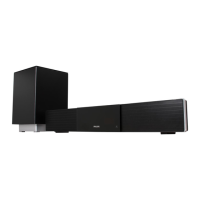


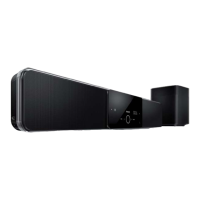

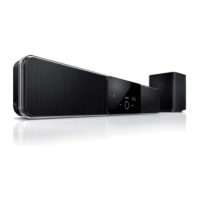
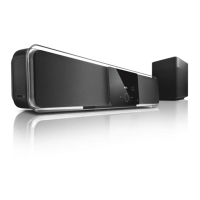
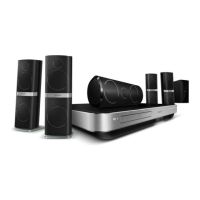
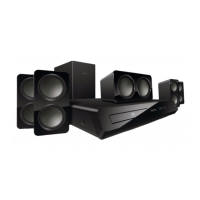

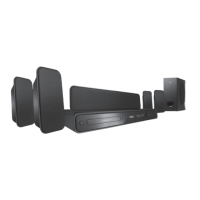
